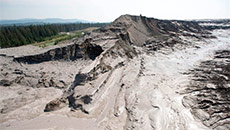CALGARY — A pipeline at Nexen's Long Lake oilsands project in northeastern Alberta has failed, spilling an estimated five million litres of bitumen, produced water and sand.
The company, which was taken over by China's CNOOC Ltd. in 2013, said the affected area is about 16,000 square metres, mostly along the pipeline's route.
The company and the Alberta Energy Regulator say it's too soon to say what might have caused the leak
AER spokesman Peter Murchland said it's been contained.
"They've effectively stopped the source of the release, so that's good news," he said.
Nexen said the spill was discovered Wednesday afternoon.
The company is investigating how long the pipeline was leaking before it was shut off, spokesman Kyle Glennie said in an email.
A portion of the Long Lake operations has been shut down, but Nexen did not disclose production figures.
So far, there has been no reported harm to the public or wildlife. The regulator is requiring Nexen to implement a wildlife protection plan in the area.
The emulsion has not flowed into a body of water, but it did spill into muskeg, the AER said.
Officials with the regulator are on site to assess the situation, start investigating and ensure Nexen meets safety and environmental requirements during the cleanup.
"As provincial premiers talk about ways to streamline the approval process for new tar sands pipelines, we have a stark reminder of how dangerous they can be," Greenpeace said in a news release about the latest spill.
"This leak is also a good reminder that Alberta has a long way to go to address its pipeline problems and that communities have good reasons to fear having more built."
Canada's premiers are meeting in St. John's, N.L., and one topic of discussion is a national energy strategy.
Long Lake, about 35 kilometres southeast of Fort McMurray, uses steam to heat oilsands bitumen deep underground, enabling it to flow to the surface.
The Nexen spill is one of the bigger ones in recent years.
In March, the AER investigated a spill of about 2.7 million litres of condensate at Murphy Oil's Seal oilfield in northwestern Alberta. Condensate is used to dilute heavy oil so it can flow through pipelines.
In 2011, about 4.5 million litres of oil leaked from a Plains Midstream pipeline into marshlands near the northern Alberta community of Little Buffalo. A year later, about half a million litres of oil spilled from another Plains pipeline in central Alberta.





